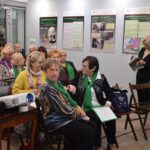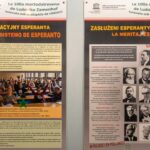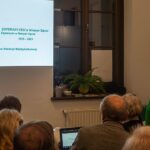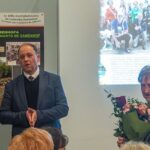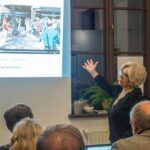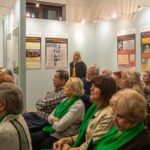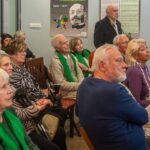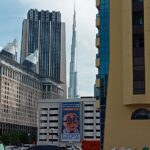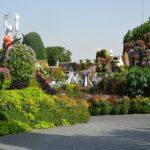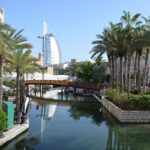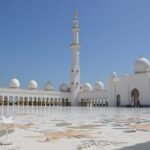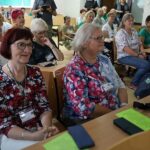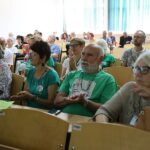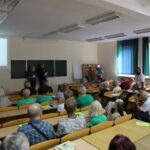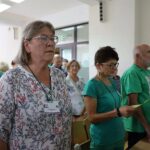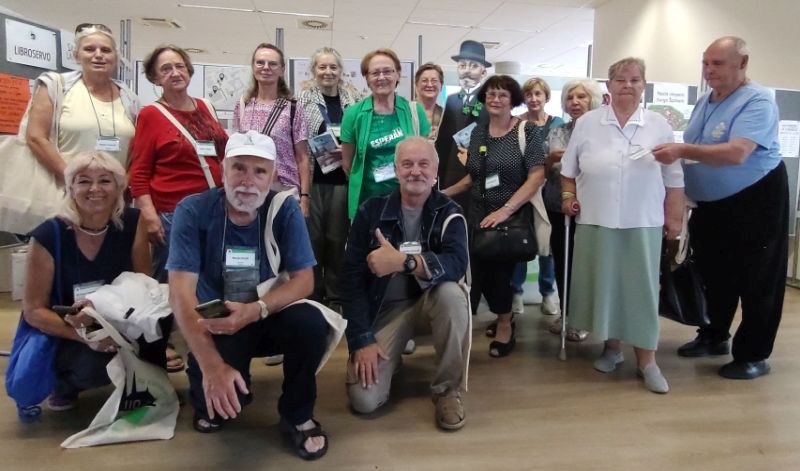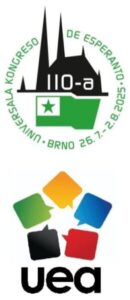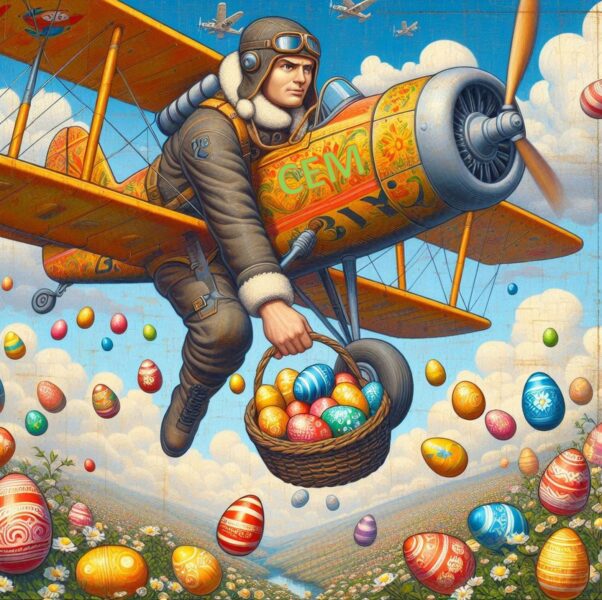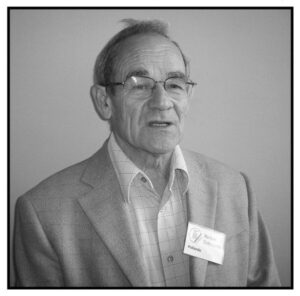
With great sadness we received the news of the passing of Roman Dobrzyński. He was for us not only a dear friend, but also a man of extraordinary sensitivity, intelligence, and sense of humor, which could brighten even the most difficult moments.
Roman was an outstanding Esperantist, whose passion for the Esperanto language turned into tangible works. He created books that not only promoted this language, but also showed its beauty and presence in the world, in people, cultures, and everyday stories.
Through his films he presented the activities of Esperanto communities on various continents, including Japan and Brazil, thereby bringing the idea of Esperanto closer to thousands of people and making the ideals of mutual understanding and openness more tangible.
We have lost not only a remarkable specialist and ambassador of the idea that unites people across borders, but above all a good, wise, and kind man. His creativity, work, and presence will forever remain with us — in our memories, conversations, and in his works, which will continue to inspire.
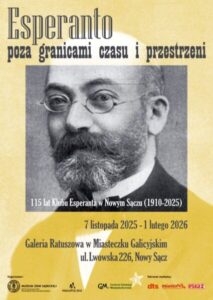 Museum of the Sądecki Region in Nowy Sącz, together with the Center for Intercultural Education, organized the exhibition “Esperanto beyond the boundaries of time and space”. The exhibition will last for three months and is located in the town hall building of the Galician Town. It was officially opened on November 7, 2025..
Museum of the Sądecki Region in Nowy Sącz, together with the Center for Intercultural Education, organized the exhibition “Esperanto beyond the boundaries of time and space”. The exhibition will last for three months and is located in the town hall building of the Galician Town. It was officially opened on November 7, 2025..
Panels in Esperanto and Polish, illustrating the life and achievements of Ludwik Zamenhof and providing many interesting facts about the Esperanto movement in Poland and abroad, were originally prepared in 2017 on the centenary of Zamenhof’s death. That year was declared by UNESCO as the Year of Zamenhof (alongside Tadeusz Kościuszko), following a proposal from the Ministry of Culture and National Heritage, and indirectly from Polish Esperantists.
During that time, several years of efforts to include Esperanto on the List of Intangible Cultural Heritage in Poland were finalized. One of the panels depicts the moment when the decision was handed over to Halina Komar and Kazimierz Krzyżak by the Deputy Minister of Culture.
Alongside the panels, a brochure featuring the same photos was published. The publishers were the Ministry of Culture, the Polish Embassy in Seoul, and the Center for Intercultural Education. The embassy in South Korea was involved because the World Esperanto Congress took place in Seoul in 2017, with over 1,000 participants from dozens of countries. The brochure was published in Esperanto and English to reach the widest possible non-Polish-speaking audience.
The opening ceremony program included an official welcome by the deputy director of the museum, a greeting from the president of the Center for Intercultural Education, and thanks to the museum staff for enabling the presentation of Esperanto achievements to a broader audience.
Special thanks go to Alicja Skalska, Maria Baran, Jarosław Szewczyk, and Marian Kocyk for their contributions to organizing the exhibition.
After watching a simulated greeting by Zamenhof himself (using Artificial Intelligence), we sang the Esperanto anthem accompanied by Alicja Skalska on the accordion.
Next, we listened to a lecture by Maria Baran titled “115 Years of Esperanto in Nowy Sącz”.
We learned many details about the activities of the local branch of the Polish Esperanto Association in Nowy Sącz, as well as the work of the Center for Intercultural Education, which has existed since 2012 as an independent non-governmental organization with a broader range of interests. In addition to Esperanto courses, we have added English language courses.
Finally, we raised a toast to the successful initiative and enjoyed a white-and-green cake – the colors of Esperanto. Guests could also view various types of Esperanto-language publications displayed in showcases.
Bożena Kocyk
From October 20 to 25, 2025, Nowy Sącz was visited by a group of Lithuanians from the University of the Third Age in Panevėžys. Our association enriched their stay by participating in and organizing several program activities, especially since the visit took place as part of the Erasmus program, in which CEM is also involved. One of the participants was a Lithuanian Esperantist, who proved invaluable, as Esperanto was our primary language of communication.
One of the CEM members – Marian Kocyk – guided the group around Nowy Sącz, showing them the most interesting places and the most important historical landmarks of the city.
The following day, a meeting was held between CEM members and the Lithuanian group, during which we discussed the activities of our associations and the specifics of working with seniors.
Bożena and Marian Kocyk also accompanied the group to Kamienna, to the “Honey Clinic” center, which specializes in apitherapy. Workshops were held there, led by an expert in beekeeping and related topics. Esperanto was again very useful for translation.
The final item on our side was a presentation by B.M. Kocyk titled “Dubai – Luxury in the Desert”, featuring beautiful travel photos and interesting information about the United Arab Emirates.
The guests from Lithuania surely took home fond memories of their stay in our city.
Bożena Kocyk
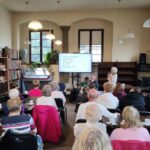 A club meeting of CEM members inaugurating the new year of the association’s activities took place at the Public Library in Nowy Sącz.
A club meeting of CEM members inaugurating the new year of the association’s activities took place at the Public Library in Nowy Sącz.
The first item on the agenda was a presentation of memories and photos from a trip to the United Arab Emirates, prepared by Bożena and Marian Kocyk, titled “Luxury in the Desert”. This part of the meeting was open to the public and attracted many travel enthusiasts and regular attendees of library events.
At the beginning, we learned several details about the history, geography, and economic situation of the Emirates.
The most important of them is Dubai, which in 60 years grew from a city of 60,000 inhabitants into a metropolis of over 3 million. Huge oil reserves enabled investments unseen elsewhere. It is home to the tallest building in the world – Burj Khalifa, with 150 floors, offering a panoramic view of the entire area. Another remarkable building, shaped like a sail, is Burj Al Arab – the tallest and most luxurious hotel in the world.
Undoubtedly, the biggest attraction is the Palm Islands – artificially created areas connected to the mainland, shaped like a palm trunk and leaves. They host apartment buildings, hotels, shopping malls, and amusement 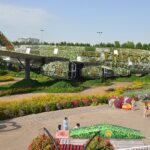 parks. Only one of the islands was completed, as unexpected difficulties delayed the construction of the remaining two.
parks. Only one of the islands was completed, as unexpected difficulties delayed the construction of the remaining two.
An attraction of a completely different style is the Miracle Gardens, featuring life-sized objects such as an airplane made entirely of flowers. In total, 1.5 million flowers were used throughout the garden. In Abu Dhabi, notable sites include the Sheikh Zayed Mosque and the Presidential Palace.
In the second part of the meeting, reserved for CEM members only, the work plan for the upcoming season was discussed. Esperanto and English language courses, club meetings, and excursions will continue. In cooperation with the Regional Museum in Nowy Sącz, an exhibition titled “Esperanto – A Window to the World” will be opened, and as every year, Zamenhof Days will be organized in December.
Bożena Kocyk
The Center for Intercultural Education supported a very interesting initiative to promote our local artist, Stanisław Chomiczewski, who resides in Uhryń.
On September 25, 2025, the vernissage of the exhibition “Art That Moves” took place at the Galaxy Hotel in Kraków. During the event, an auction of the artist’s works was held, with proceeds supporting the charitable activities of the Lions Clubs in Kraków — the main organizers of the exhibition and vernissage. As a unique part of the program, guests could witness and take part in a photo session with the artist in front of the hotel on a real horse, participate in the painting auction, and enter a drawing for a painting among those who purchased the exhibition catalog.
Students from the Kraków Flamenco School enriched the celebration with a magnificent flamenco dance performance. Several members of the CEM had the pleasure of attending this event.
“Chomiczewski’s paintings teach us about Poland, make us aware of our identity. They transport our egoistic entanglement in everyday ‘self’ into a metaphysical space that offers a sense of authentic freedom” – Zofia Weiss, art critic.
Bożena Kocyk
Strona www artysty Profil FB artysty
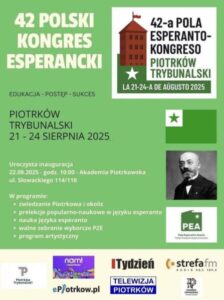 From August 20 to 24, 2025, the next congress took place – this time in Piotrków Trybunalski. The city is located in the very heart of Poland and is known for having hosted the Crown Tribunals – the highest courts of the former Polish-Lithuanian Commonwealth – for nearly two centuries.
From August 20 to 24, 2025, the next congress took place – this time in Piotrków Trybunalski. The city is located in the very heart of Poland and is known for having hosted the Crown Tribunals – the highest courts of the former Polish-Lithuanian Commonwealth – for nearly two centuries.
The congress was attended by 77 participants, including 2 foreigners and 3 representatives of our association. All meetings, gatherings, and concerts were held at the facilities of the Piotrków Academy, a higher education institution. Accommodation was arranged in the university’s student dormitory.
On the first day, a sightseeing trip was organized to showcase interesting places in the area. These included:
• Sulejów, with its well-preserved Cistercian monastery complex,
• Inowłódz, featuring the unique Romanesque church of St.Giles,
• Spała, known for its Olympic training facilities and as a summer retreat for Polish presidents,
• And finally, the massive concrete bunkers for trains in Konewka, built by the Germans during World War II for military command purposes.
The congress program featured engaging lectures, such as Maciej Jaskot, editor of Pola Retradio, with “One Language Is Not Enough”, and Maciej Zięba’s “African Philosophy.” There was also a presentation by our members Bożena and Marian Kocyk titled “Dubai – Luxury in the Desert.”
As always, there were concerts, group singing, dancing, and quizzes, and on Sunday, a Holy Mass celebrated in Esperanto.
The General Assembly of PEA members also took place, during which a new board and audit committee were elected, and necessary amendments to the statute were approved.
Bożena Kocyk
From July 26 to August 2, 2025, the 110th World Esperanto Congress took place in Brno, Czech Republic. The sessions and most of the events were held at Mendel University, in the modern building of the Faculty of Business and Economics. The motto of this year’s gathering was: “Esperanto and technologies as bridges of peace and trust between nations.” This theme appeared in many lectures, discussions, and panels, highlighting the relevance of the international language in a world where communication increasingly relies on digital tools and new technological solutions.
Nearly a thousand participants came to Brno – in total, 1,132 people from 63 countries registered, of whom 947 attended the congress in person. The largest group consisted of the hosts, Esperanto speakers from the Czech Republic, followed closely by participants from Germany, Poland, and France. The age range was remarkably wide: the youngest participant was only one year old, while the oldest was 98. The average age was 58, with a median of 63, but importantly, 135 young Esperanto speakers associated with TEJO (the World Esperanto Youth Organization) also took part, showing that the movement still has a young generation of successors.
The program was rich and diverse. The congress opened with a ceremonial inauguration, featuring speeches from local authorities, UEA leadership, and invited guests from various countries. In the following days, numerous lectures and thematic sessions took place, devoted not only to language and culture but also to the role of Esperanto in the context of globalization and new technologies. Regular features of the program included language courses and exams, the Esperanto movement fair, and the Esperanto bookshop.
A vibrant cultural program was also an integral part of the event. Concerts, theater performances, artistic shows, and communal singing were held daily, bringing participants together in university halls and courtyards. Excursions in and around Brno were organized as well, giving guests the opportunity to discover both the historic landmarks and the modern face of the Czech Republic. For young people, a separate series of meetings and workshops was prepared, encouraging integration and the exchange of experiences.
The congress atmosphere was documented daily by the bulletin “Drako de Brno”, which published reports on the most important events, program announcements, and interviews with participants. It served not only as an information source but also as a kind of chronicle of the entire meeting.
The next, 111th World Esperanto Congress will be held from August 1st to 8th, 2026, in Graz, Austria. Already, many participants from Brno have announced their intention to attend, proving that the tradition of world congresses continues to enjoy lasting popularity and attracts new generations.
transl. Admin
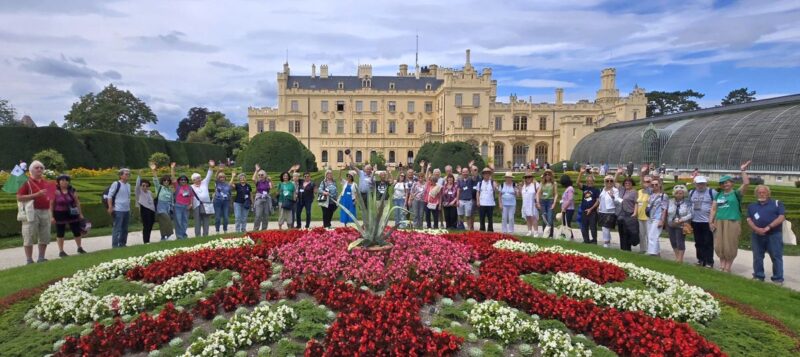
 If you prefer to use text addresses instead of scanning QR codes, they are as follows:
If you prefer to use text addresses instead of scanning QR codes, they are as follows:
Photos of participants:
https://photos.google.com/u/1/share/AF1QipOjufNYoeoCuvO7bw1Dm1ycwP4icOdnk0txGxhur6xVTdqedF-TekMIVxH7_olHsw?key=QjRFVlh5VGZsWnBpUTJyVU1BTzdfVWZjUXR6QktR
Photos of our group:
https://photos.app.goo.gl/fRLSZXJq5tuae3hk8
For this year’s bonfire celebration marking the end of the year of studying Esperanto and English languages, CEM chose a campsite located in a picturesque valley in Uhryń, beneath Hala Łabowska.
Monday, May 19th, greeted us with cold and rain. Lighting the bonfire was nearly a miracle – let alone preparing any food.
Fortunately, our visit to the nearby private Art Gallery of painter Mr. Stanisław Chomiczewski, a graduate of the Academy of Fine Arts in Kraków, turned out to be rich not only in aesthetic and spiritual experiences.
Mr. and Mrs. Ewa and Stanisław Chomiczewski graciously provided us with shelter, lent us a grill, and gave us a guided tour of their home, which is steeped in the spirit of history and art.
In the Artist’s studio, we learned about his working process. Mr. Stanisław told us about the history and tragic fate of the Lemko people who lived in these areas before World War II.
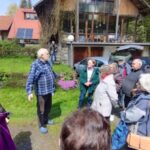
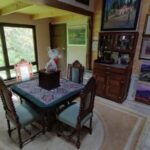
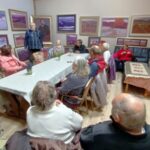
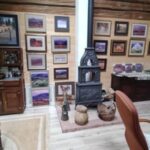
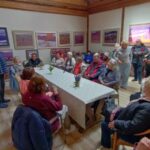
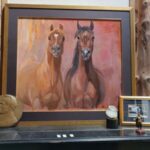
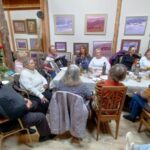
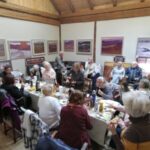
Together, we sang scout songs and tunes from the Łowczówek region, accompanied by an accordion and surrounded by oil portraits of Marshal Piłsudski, herds of horses, and charming landscapes of the Sądecki region – adding to the magical atmosphere of this remarkable gathering. At the end, we received exhibition catalogues of Mr. Stanisław’s work, each with a personalized dedication and autograph.
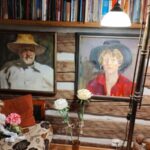
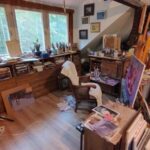
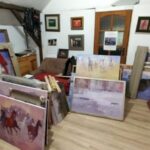
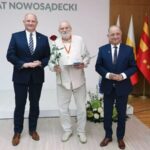
Breaking news: During the ceremonial session of the Nowy Sącz County Council on June 13th, 2025, Stanisław Chomiczewski was awarded the badge of “Meritorious for the Sądecka Land.” This recognition crowns the 50th anniversary of the Artist’s creative work.
Alicja Skalska, transl. Admin
From April 7th to 11th, 2025, a group of 20 of our members went on a trip to Toruń. The aim, apart from meeting with Esperantists, was to explore one of the most beautiful cities rich in historical monuments. The train journey from Kraków to Toruń was quick and comfortable. From the station, we efficiently took taxis to the B&B Hotel, located in the very center of the city.
The next day, after a delicious breakfast, we started implementing a very rich and interesting program of city exploration. We saw the Old Town Square, the Town Hall, the Copernicus Monument, the “House Under the Star,” the Artus Court which included a gingerbread shop inside the Flisak Fountain, the Church of the Holy Spirit, the Main Post Office and the Church of the Virgin Mary. For each location, we listened to a brief history and interesting anecdotes associated with it.
In the Museum of Gingerbread, besides exploring the exhibits with a guide and tasting gingerbread, we participated in workshops making decorative gingerbread.
In the afternoon, we visited the Leaning Tower, the Gothic Granary, the Baroque Granary, the Monastic Gate, the Pigeon Gate, the Sailor’s Gate, the Cathedral of St. John, the Bridge Gate, the Bourgeois Court, the Guard Tower with a residence, and the ruins of the Teutonic Castle surrounded by historic townhouses.
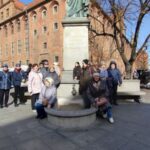

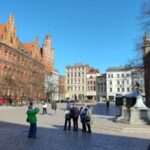
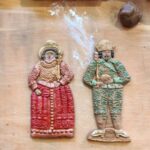
In the evening, we participated in one of the most famous and revolutionary stage works of the 20th century – “Jesus Christ Superstar.” The Toruń adaptation was created in the form of immersive theater where the boundary between stage and audience is blurred, and viewers are actively engaged in the performance. The venue for the performance was the concert hall of the iconic Toruń music club “Od Nowa.” The performance left an extraordinary impression on us.
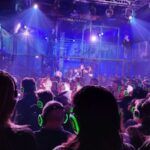
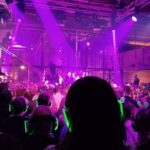
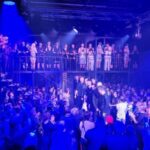
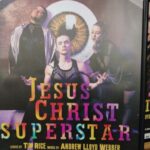
The next day, we climbed the observation tower of the Old Town Hall, which offers a beautiful panorama of the city. We also saw exhibitions dedicated to the history of Toruń. Then, we visited the Ethnographic Museum with its open-air section in the city center, guided by Ms. Maria – an Esperantist and a long-time employee of the museum with extensive knowledge of the exhibits and their history. In the afternoon, we individually explored selected places and attractions in the city.
In the evening, we had an interesting meeting with an Esperantist from Toruń, during which we exchanged fascinating information about the activities of both clubs.
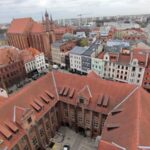
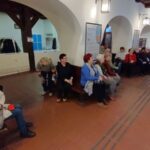
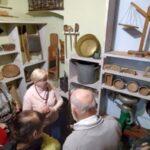
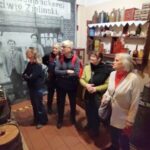
On the third day, we visited: the Copernicus Museum, the Museum of the History of Toruń, the “Invisible House” – for the brave and then strolled across the Piłsudski Bridge to the other side of the Vistula River to the observation tower and the ruins of the Dybów Castle.
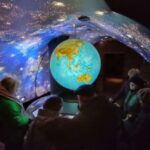

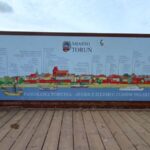
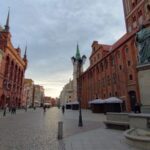
On the last day, we individually walked around the old Toruń, reminiscing about the pleasant and interesting moments. Despite the very rich program of the trip, everyone found time to relax with a meal and do some individual sightseeing. Full of unforgettable experiences, we returned by train to Kraków. We will remember this well-organized and fascinating trip for a long time.
Barbara Połomska





